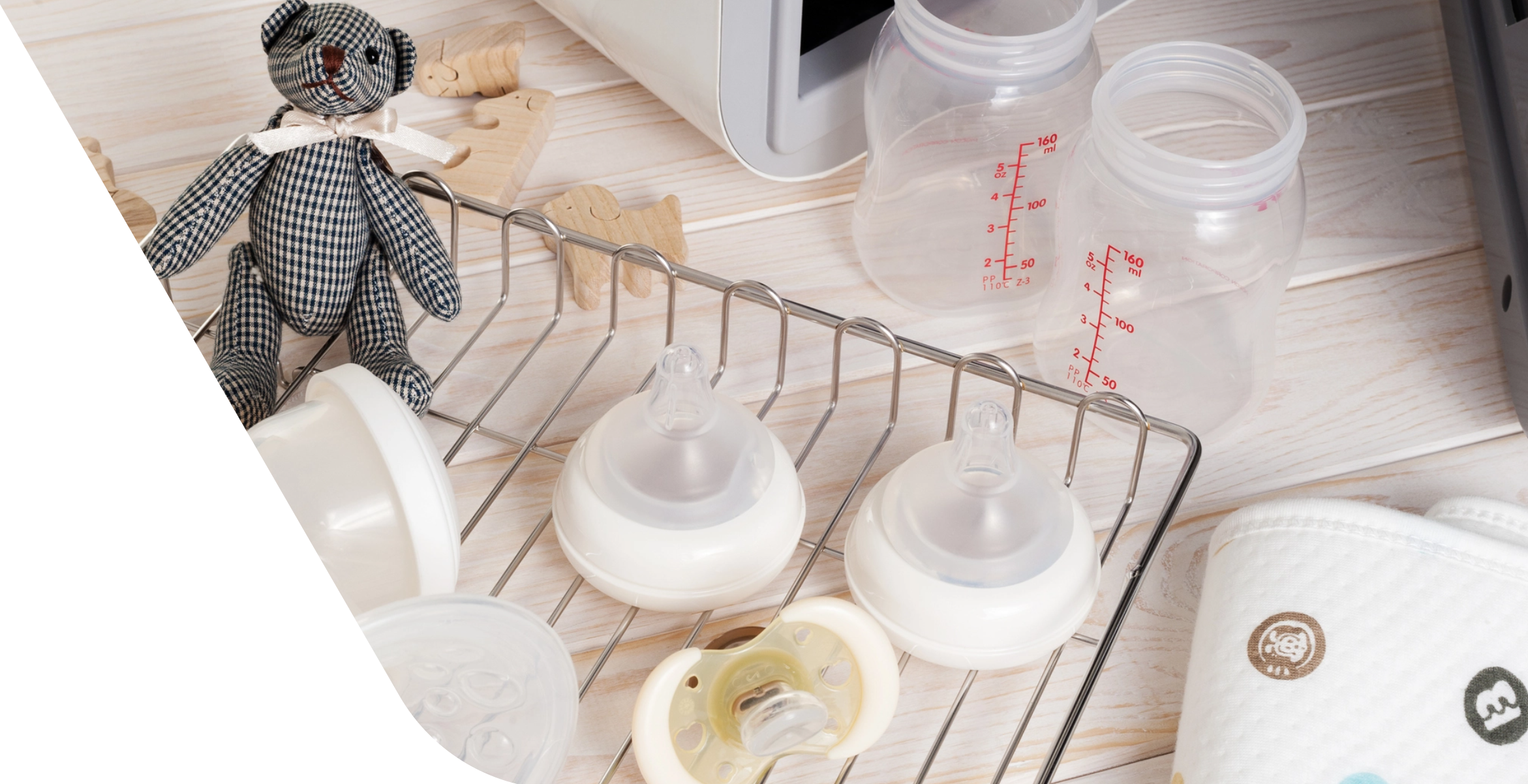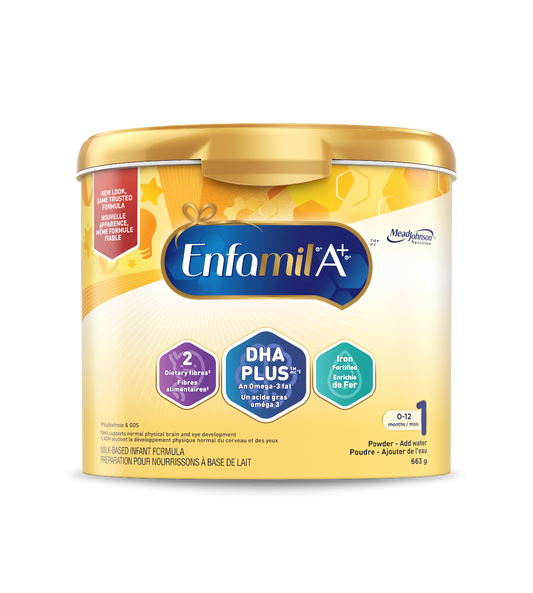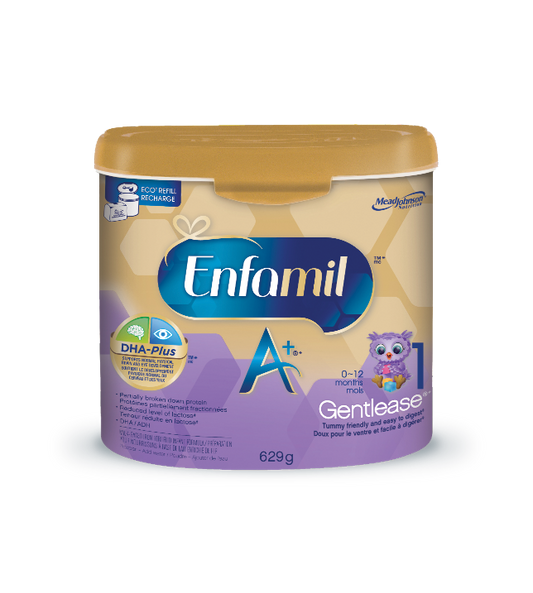Knowing how much to feed a baby can be tricky. There is a learning curve when it comes to breastfeeding and formula-feeding, and it’s completely normal to have some questions. This comprehensive roundup should provide you with the information you need to feel comfortable and confident knowing how much and how often to feed your baby.
Every baby is different, and feeding amounts can vary depending on the child. In addition, breastfeeding moms may face separate questions than moms who choose to formula-feed. This article is broken down into a few different sections to answer any and all of your questions about how much your baby should eat:
- How Much to Feed a Baby: The Basics
- How Do I Know If My Baby Is Hungry?
- Breastfeeding: 0-12 Months
- Formula-Feeding: 0-12 Months
- Baby Feeding Chart: First Year
- Tips for Transitioning to Solids
How Much to Feed a Baby: The Basics
Right from the start, your baby needs the right nutrition to support healthy development. The Canadian Pediatric Society, Health Canada, Breastfeeding Committee for Canada and Dietitians of Canada recommend exclusively breastfeeding for the first six months, as breastmilk will provide your baby with all of the nutrition that they need. After six months you can begin introducing solid foods. They further recommend that if you are breastfeeding, you give your baby a daily Vitamin D supplement of 400 IU. If breastfeeding is not an option, don’t worry: Infant formula like Enfamil A+ is designed to meet the nutritional requirements your baby needs.
Feeding Highlights for Year One
- For the first six months, breastmilk and/or baby formula will provide your baby with the nutrition they need.
- Initially, most babies do not need breastfeeding and formula feeding schedules. However, they will settle into more of a routine as they get older
- Whether you are breastfeeding or formula-feeding, it is important to listen to your baby’s feeding cues and feed them according to their hunger.
- Around six-months old is when you can begin to introduce solid foods to your baby’s diet (see: Tips for Transitioning to Solids) below.
How Often Should I Feed My Baby?
First things first: let’s talk about how to tell if your baby is hungry. The good news is that whether you’re breastfeeding or formula-feeding, your baby is the single best authority for when
SIGNS YOUR BABY IS HUNGRY
SIGNS YOUR BABY IS FULL
Breastfeeding: 0-12 Months
You will be breastfeeding “on demand”—whenever your baby is expressing that they’re hungry. As far as knowing how much you should be breastfeeding your baby goes, both the amount of weight they gain and the number of wet diapers (six or more per day) are good indicators of proper nutrition. Every baby is different, but this could be feeding as often as about every two to three hours, or between eight to twelve times per day. Typically, how often a baby will feed decreases over time as they consume more during each feeding. Baby will begin getting additional nutrition from other sources once solid foods are introduced, which may also cause some changes in breastfeeding habits.
Formula-feeding: 0-12 Months
On average, formula-fed babies eat every three to four hours during their first weeks, when their stomach is small. However, after a few weeks the amount consumed at each feeding will increase and the number of feedings will decrease—baby will eat more but less often. Like with breastfeeding, proper weight gain and number of wet diapers are the best indicators of whether your baby is getting enough food.
Enroll in our program to receive up to $160 in coupons, plus free baby products and formula samples!
Baby Feeding Chart: First Year
If you are exclusively formula feeding, refer to our baby feeding chart for information on how much formula to feed your baby. Our formula baby feeding chart is a guide to how much newborns should eat, along with how much formula to feed a baby after six months. But remember, these are just averages—your little one’s appetite is always the best guide to how much and how often to feed baby.
| AGE |
BOTTLES per day |
APPROXIMATE AMOUNT OF FORMULA per bottleper day |
|
|---|---|---|---|
|
|
5 -10 | 59 mL (2 fl oz) - 89mL (3 fl oz) | 410-800 mL (14-27 fl oz) |
| 4-7 | 89 mL (3fl oz) - 150 mL (5 fl oz) | 590-1050 mL (20-35.5 fl oz) | |
| 4-5 | 135 mL (5 fl oz) - 205 mL (7 fl oz) | 540-1030 mL (18-35 fl oz) | |
| 4-6 | 135 mL (5 fl oz) - 175 mL (6 fl oz) | 540-960 mL (18-32 fl oz) | |
| 3-4 | 175 mL (6 fl oz) - 250 mL (8 fl oz) | 500-750 mL (17-25 fl oz) | |
Tips for Transitioning to Solids
After about six months is when things usually begin to get a little bit more interesting—and varied— as far as it concerns your baby’s diet and feeding schedule, as this is when you will get to introduce and explore different solid foods. According to the Canadian Paediatric Society, there is no particular order in which you should introduce solid foods to your baby, and it does not recommend delaying any particular foods, like peanuts, in order to prevent possible allergies.
- Start slow. Transitioning is a gradual process, and it’s important to give your baby time to adjust.
- Start simple. Single-ingredient foods without sugar or salt will be easier on your baby’s tummy. If they have a negative reaction, it will be easy to determine the source.
- Consider baby cereals to start. Mix one tablespoon of cereal with four tablespoons of breastmilk or formula. It will help make the transition for your baby more gradual.
- As your baby grows more comfortable, slowly introduce vegetables, fruits and meats into their diet. Always consult your doctor before introducing a new food.
- Avoid honey in the first year. In rare cases, it causes infant botulism. Also avoid hot dogs, peanut butter, nuts, popcorn or any other food that could be a choking hazard.
- Feed with a spoon since this will be your one of your child’s primary utensils eventually.
- Always serve the appropriate texture of food for your baby. He may start with pureed food, then move to mashed, chopped and finger foods as he gets older.
If you’re unsure when to begin, talk to your doctor about when is precisely the right time for your baby to start eating solid foods.
We hope we helped answer your questions on how much to feed a baby. For more information on feeding amounts, explore our Feeding Guide.
Looking for coupons, free baby products and formula samples? Join our My Family Beginnings by Enfamil A+ program today!
Tip: There are formulas for babies with special feeding needs (such as allergies or intolerances).Check out our hypoallergenic baby formula products to learn more.








